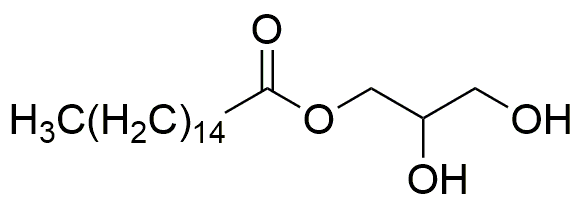Monopalmitin is widely utilized in research focused on:
- Food Industry: It serves as an emulsifier in food products, helping to blend ingredients like oil and water, which improves texture and stability in items such as margarine and baked goods.
- Cosmetics: Commonly found in creams and lotions, it acts as a moisturizer and stabilizer, enhancing the product's feel and effectiveness on the skin.
- Pharmaceuticals: Used as a drug delivery agent, it helps in the formulation of lipid-based drug carriers, improving the solubility and bioavailability of certain medications.
- Biotechnology: In cell culture, it is employed to support cell membrane integrity and promote cell growth, making it essential for research in cellular biology.
- Industrial Applications: Monopalmitin is utilized in the production of surfactants and lubricants, providing excellent wetting properties and reducing friction in various manufacturing processes.
General Information
Properties
Safety and Regulations
Applications
Monopalmitin is widely utilized in research focused on:
- Food Industry: It serves as an emulsifier in food products, helping to blend ingredients like oil and water, which improves texture and stability in items such as margarine and baked goods.
- Cosmetics: Commonly found in creams and lotions, it acts as a moisturizer and stabilizer, enhancing the product's feel and effectiveness on the skin.
- Pharmaceuticals: Used as a drug delivery agent, it helps in the formulation of lipid-based drug carriers, improving the solubility and bioavailability of certain medications.
- Biotechnology: In cell culture, it is employed to support cell membrane integrity and promote cell growth, making it essential for research in cellular biology.
- Industrial Applications: Monopalmitin is utilized in the production of surfactants and lubricants, providing excellent wetting properties and reducing friction in various manufacturing processes.
Documents
Safety Data Sheets (SDS)
The SDS provides comprehensive safety information on handling, storage, and disposal of the product.
Product Specification (PS)
The PS provides a comprehensive breakdown of the product’s properties, including chemical composition, physical state, purity, and storage requirements. It also details acceptable quality ranges and the product's intended applications.
Certificates of Analysis (COA)
Search for Certificates of Analysis (COA) by entering the products Lot Number. Lot and Batch Numbers can be found on a product’s label following the words ‘Lot’ or ‘Batch’.
*Catalog Number
*Lot Number
Certificates Of Origin (COO)
This COO confirms the country where the product was manufactured, and also details the materials and components used in it and whether it is derived from natural, synthetic, or other specific sources. This certificate may be required for customs, trade, and regulatory compliance.
*Catalog Number
*Lot Number
Safety Data Sheets (SDS)
The SDS provides comprehensive safety information on handling, storage, and disposal of the product.
DownloadProduct Specification (PS)
The PS provides a comprehensive breakdown of the product’s properties, including chemical composition, physical state, purity, and storage requirements. It also details acceptable quality ranges and the product's intended applications.
DownloadCertificates of Analysis (COA)
Search for Certificates of Analysis (COA) by entering the products Lot Number. Lot and Batch Numbers can be found on a product’s label following the words ‘Lot’ or ‘Batch’.
*Catalog Number
*Lot Number
Certificates Of Origin (COO)
This COO confirms the country where the product was manufactured, and also details the materials and components used in it and whether it is derived from natural, synthetic, or other specific sources. This certificate may be required for customs, trade, and regulatory compliance.

